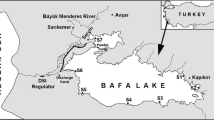Abstract
In limnetic ecosystem, water quality depends upon physical, chemical, and biological factors. Effects of temperature, light scattering, and absorption by suspended and dissolved matter, transport, and mixing of nutrients within the lake are the significant factors as far as water quality is concerned. Nutrient loading into the lake and internal cycling of nutrients is always a matter of concern and critical to number of processes. During the winter season, heat and momentum transfer at the lake surface and the temperature-density relation of water destabilize the water column and drive vertical mixing and transport processes. The deepening of the surface layer produces nutrient transfer from the hypolimnion into the euphotic zone of epilimnion. It may also resuspend sediments that would have settled under stratified conditions, or redistribute particles that may still be in suspension. Thus, there exists a complex connection between the hydrodynamics and water quality issues. Present study is an effort to understand how seasonal changes in the limnetic ecosystem regulate the limnochemistry and movement of nutrient. The study revealed that significant variations of nutrients and organic load were observed between epilimnion and hypolimnion during summer season, and the lake was found in hyper-eutrophic condition throughout the study period.
















Similar content being viewed by others
References
APHA. (1998). Standard methods for the examination of water and wastewaters (20th ed.). Washington, DC: APHA, AWWA, WEF.
Bricker, S. B., Clement, C. G., Pirhalla, D. E., Orlando, S. P., & Farrow, D. R. G. (1999). National Estuarine Eutrophication Assessment: Effects of nutrient enrichment in the nation’s estuaries. Silver Spring: NOAA, National Ocean Service, Special Projects Office and the National Centers for Coastal Ocean Science, p. 71.
Carlson, E. R. (1977). A tropical state index for lakes. Limnology and Oceanography, 22(2), 361–369.
Carlson, R. E. (1992). Expanding the trophic state concept to identify non-nutrient limited lakes and reservoirs. In Proceedings of a National Conference on Enhancing the States’ Lake Management Programs. Monitoring and Lake Impact Assessment. Chicago, pp. 59–71.
Dhote, S., Varghese, B., & Mishra, S. M. (2001). Impact of idol immersion on water quality of twin lakes of Bhopal. Indian Journal of Environ. Prot., 21, 998–1005.
Glibert, P. M., Magnien, R., Lomas, M. W., Alexander, J., Fan, C., Haramoto, E., Trice, M., & Kana, T. M. (2001). Harmful algal blooms in the Chesapeake and coastal bays of Maryland USA: Comparison of 1997, 1998, and 1999 events. Estuaries, 24(6A), 875–883.
Howarth, R., Anderson, D., Cloern, J., Elfring, C., Hopkinson, C., Lapointe, B., Malone, T., Marcus, N., McGlathery, K., Sharpley, A., & Walker, D. (2000). Nutrient pollution of coastal rivers, bays, and seas. Issues Ecology, 7, 1–16.
ICMR. (1975). Manual of standards of quality for drinking water supplies. New Delhi: ICMR.
ICWE. (1992). The Dublin Statement and report of the conference. International Conference on Water and the Environment: Development Issues.
ILEC. (2003). World lake vision: A call to action. Kusatsu: ILEC.
Information sheet on Ramsar Wetlands (2011) http://www.wetlands.org/reports/ris/2IN011en.pdf. Accessed on 10 Mar 2011.
Misra, S. M., Pani, S., Bajpai, A., & Bajpai, A. K. (2001). Assessment of trophic status by using Nygaard Index with special reference to Bhoj wetland. Pollution Research, 20(2), 147–153.
OECD. (1982). Eutrophication of waters. Monitoring, assessment, and control (p. 154). Paris: Organization for Economic Co-operation and Development.
Reokhow, K. H., & Chapra, S. C. (1983). Lake quality indices, engineering approaches for lake management (Vol. 1). London: Butterworth.
Sarwar, S. G., & Wazir, A. (1991). Physicochemical characteristics of a freshwater pond of Shrinagar (Kashmir). Pollution Research, 10(4), 223–227.
Singh, K. P., Malik, A., Mohan, D., & Sinha, S. (2004). Multivariate statistical techniques for the evaluation of spatial and temporal variations in water quality of Gomti River (India): a case study. Water Research, 38, 3980–3992.
Vega, M., Pardo, R., Barrado, E., & Deban, L. (1998). Assessment of seasonal and polluting effects on the quality of river water by exploratory data analysis. Water Research, 32, 3581–3592.
Vollenweider, R. A. (1968). Scientific fundamental of the eutrophication of lakes and flowing water in particular reference to nitrogen and phosphorous as factors in eutrophication. O.E.C.I Paris, Tech. Rep. DAS/CSI/68. 27:139.
Wetzel, R. G. (1975). Limnology. Philadelphia: Saunders, xii + 743 p.
Wetzel, A. R. (2001). Limnology (3rd ed.). USA: Academic.
Yu, F., Fang, G., & Ru, X. (2010). Eutrophication, health risk assessment and spatial analysis of water quality in Gucheng Lake, China. Environmental Earth Sciences., 59(8), 1741–1748.
Zhang, M., Xu, J., & Xie, P. (2008). Nitrogen dynamics in large shallow eutrophic Lake Chaohu, China. Environmental Geology, 55(1), 1–8. doi:10.1007/s00254-007r-r0957-6.
Acknowledgments
Authors are grateful to Principal SSL Jain College Vidisha for granting permission to carry out the present research work. The authors are also thankful to Dr. Avinash Bajpai, Placement & Training Officer of Makhanlal Chaturvedi University, Bhopal for his continuous encouragement during the research work.
Author information
Authors and Affiliations
Corresponding author
Rights and permissions
About this article
Cite this article
Upadhyay, R., Pandey, A.K., Upadhyay, S.K. et al. Limnochemistry and nutrient dynamics in Upper Lake, Bhopal, India. Environ Monit Assess 184, 7065–7077 (2012). https://doi.org/10.1007/s10661-011-2480-1
Received:
Accepted:
Published:
Issue Date:
DOI: https://doi.org/10.1007/s10661-011-2480-1




